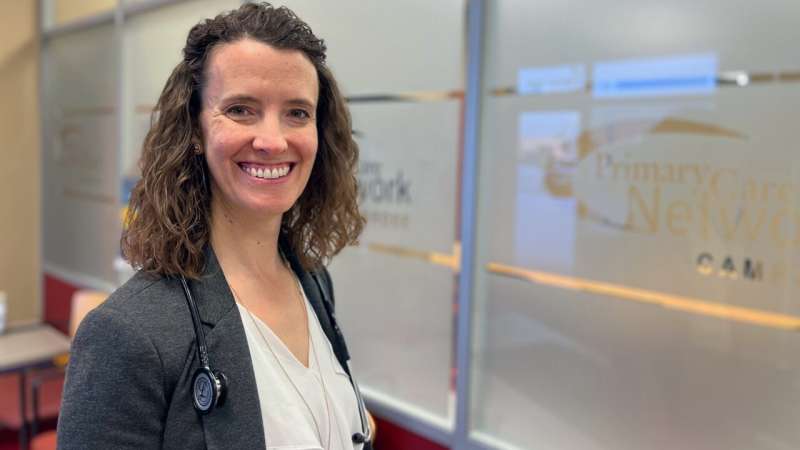This article has been reviewed according to Science X's editorial process and policies. Editors have highlighted the following attributes while ensuring the content's credibility:
fact-checked
trusted source
proofread
Rural placements for medical students in Canada feed 'pipeline' for new family docs

New research shows an innovative education program is helping to address Alberta's rural doctor shortage by making it more likely medical students will set up a rural family practice after graduation.
The University of Alberta was one of the first medical schools in Canada to set up its Rural Integrated Community Clerkship program back in 2007. It sends up to 25 third-year students for 10-month intensive work experiences with a single or small number of teaching physicians.
Instead of rotating to a new specialty placement every four to six weeks as in an urban clerkship, the students learn about surgery, pediatrics, internal medicine, psychiatry, obstetrics and gynecology in an integrated fashion in one community such as Bonnyville, Peace River, Hinton or Camrose.
"The biggest advantage the rural clerkship students have is the relationships they develop with their teachers, with their patients and with their community," explains principal investigator Jill Konkin.
In a recent study appearing in the Canadian Medical Education Journal, researchers tracked 1,105 U of A medical grads from 2009 to 2016. Of that cohort, 195 chose to become rural practitioners and 510 became family practitioners. Taking part in the rural clerkship was found to be a more reliable predictor for those choices than having a rural background.
"Integrated Community Clerkship participation had more influence than rural background on students' choice of rural and/or family practice," the authors report. "Our results show that the rural pipeline principle works."
"In the integrated clerkship, the student's curriculum is whoever walks in the door as a patient," explains principal investigator Jill Konkin, a professor of family medicine who practiced for 20 years as a family physician in Sundre and Jasper and as a locum for rural doctors.
"The biggest advantage the rural clerkship students have is the relationships they develop with their teachers, with their patients and with their community."
"We know how to make rural physicians," concludes first author Darren Nichols, associate professor of family medicine, noting that the students develop "adaptive expertise" that allows them to be ready to treat a variety of patients, rather than seeing a limited set of problems repeatedly as a specialist.
"We can take any student, regardless of background or future career plan, and provide them the opportunity to have their life changed," Nichols says. "They know how to approach any problem. That's much harder than being a specialist."
'I really fit here'
Family physician Charley Boyd's experience with the rural clerkship program is a textbook case, and now she gives back as a preceptor herself. A member of the MD class of 2015, Boyd has 700 patients in her practice in Camrose, with a focus on women's health and mental health for vulnerable teens. She also spends a week every two months working as a general practitioner in Fort Chipewyan.
Boyd grew up on a grain farm near Oyen. She loved science and people and knew she wanted to attend university. But she also wanted a job that would bring her back to a rural community. As part of her medical training, she did her 10-month clerkship in Peace River.
"It was the first time that I thought, 'I really fit here,'" Boyd recalls. "After those 10 months, I knew I was on the right career path. I felt a profound sense of relief to know that this was the work I wanted to pursue."
Boyd says it's humbling to take on medical students who are constantly asking her questions and testing her knowledge in new ways.
"It makes me a better clinician—and I'm a strong believer that the best way to recruit to rural communities is to offer learning opportunities in your town."
One of Boyd's former rural clerkship students has returned to Camrose to practice family medicine with a special interest in anesthesia; another is doing so in a British Columbia town. Another has chosen to specialize in psychiatry, but Boyd hopes they may now consider working in a regional center rather than a large urban one.
Nichols is a co-author of a recent report on ways to improve rural health care in Alberta, and he says the education pipeline is a key component, remarking, "You need to educate the rural health workforce with rural teachers in rural communities."
Konkin, Nichols and Boyd all agree training in a rural setting provides new doctors with the opportunity to build a depth and breadth of practice they could not experience in any other setting.
"It really is the best job in the world," says Konkin. "No day is the same as the day before. It challenges you intellectually, emotionally and as a person."
More information: Darren Nichols et al, The Rural Integrated Community Clerkship: a vital stretch in the Alberta rural physician workforce pipeline, Canadian Medical Education Journal (2023). DOI: 10.36834/cmej.73944





















